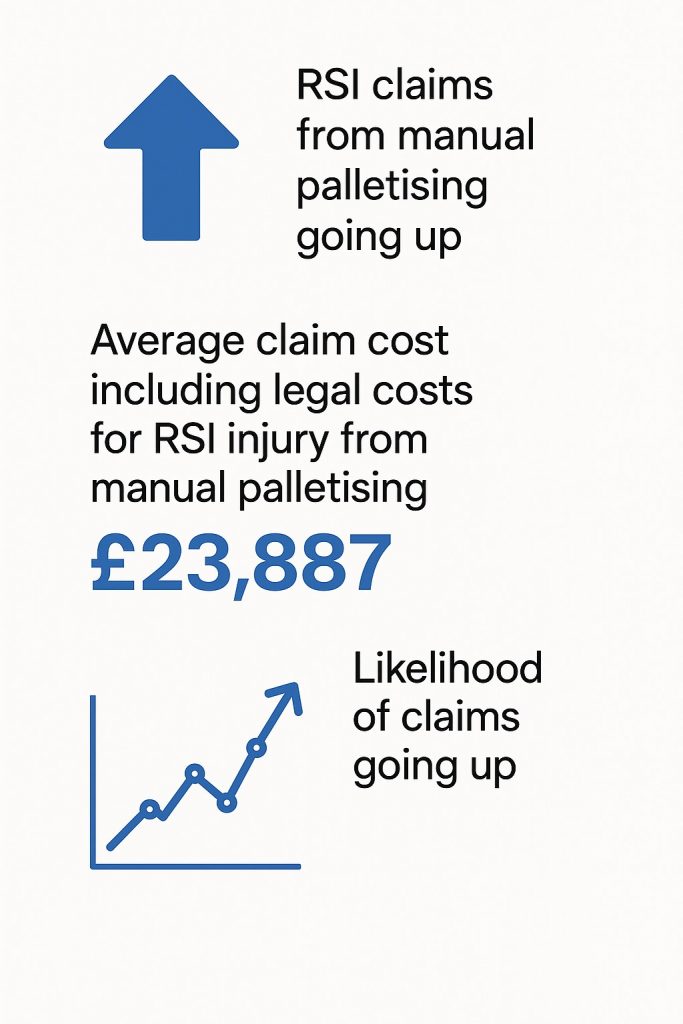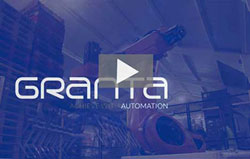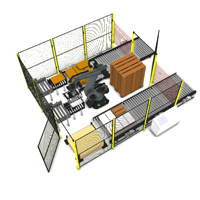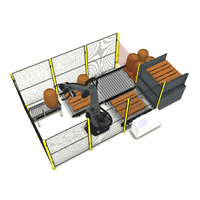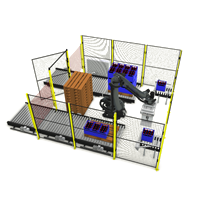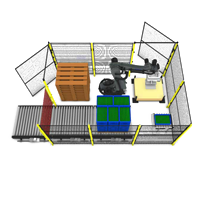Across the global industrial landscape, the hum of conveyor belts, the hiss of pneumatic tools, and the clatter of forklift wheels form the everyday soundtrack of warehousing and manufacturing. These environments are engineered for precision and efficiency — yet they remain some of the most hazardous workplaces in the world.
Each year, thousands of workers in the UK and Europe suffer injuries on the job — from repetitive strain and falls to life-altering incidents involving heavy machinery. Behind each incident is a ripple effect of disruption: lost hours, soaring insurance premiums, damaged morale, and often, years-long legal entanglements.
But while the human cost of injury is rightly front and centre, the true financial cost is often underestimated — and poorly quantified. In a sector that thrives on tight margins and just-in-time fulfilment, every injury chips away at resilience and profitability.
In this article, we explore the most common injuries in warehousing and manufacturing, break down their financial implications, and examine how automation is emerging as one of the most effective — and underused — tools in the injury prevention arsenal.
The Injury Landscape: What’s Going Wrong — and Where
Manufacturing and warehousing environments are inherently high-risk due to their physical nature, equipment density, and pace of operations. In the UK alone, over 60,000 non-fatal injuries were reported in manufacturing in the latest HSE statistics, with warehousing contributing tens of thousands more. These numbers likely underrepresent reality due to underreporting and cultural barriers around incident disclosure.
The Most Common Injury Types
Understanding the root causes of injury is the first step toward prevention. The following are the key categories dominating injury statistics:
1. Manual Handling Injuries (Musculoskeletal Disorders – MSDs)
Accounting for over a third of all reported workplace injuries in manufacturing, MSDs result from lifting, pulling, pushing, or repetitive tasks. Lower back injuries, tendonitis, and carpal tunnel syndrome are frequent consequences of poorly designed work processes.
2. Slips, Trips and Falls
Seemingly benign but frequently severe, these incidents often stem from cluttered walkways, fluid leaks, uneven flooring, or poor lighting. They’re also a leading cause of days lost from work, especially among older workers.
3. Machine Entanglements and Crush Injuries
Improper use of guarding equipment, hasty maintenance practices, and non-standard lockout/tagout procedures often result in hand, limb, or torso injuries. In high-volume manufacturing, even a momentary lapse in focus can have catastrophic consequences.
4. Struck by Moving Vehicles or Falling Objects
Forklifts and reach trucks contribute significantly to collision-related injuries. Equally, improperly stored pallets and unstable racking systems are common sources of falling-object trauma.
5. Fatigue-Related Errors
Though not always classified as injuries per se, fatigue-driven mistakes — especially during night shifts or extended peak seasons — can lead to a cascade of safety risks. Workers may ignore protocol, misjudge loads, or skip PPE.
Unpacking the Financial Toll
When injuries occur, the costs mount — often invisibly at first. Health & Safety professionals and HR leaders need to account not just for the direct costs (medical treatment, compensation), but the indirect and compounding losses that come in the aftermath.
Direct Costs: The Tip of the Iceberg
- Medical expenses and rehabilitation: These can be significant, especially in cases involving long-term physiotherapy or surgery.
- Workers’ Compensation and Employer Liability Claims: Compensation payouts can range from £5,000 for minor incidents to well over £100,000 for severe cases, including emotional distress and punitive damages.
- Legal fees and litigation: If a safety breach is proven, companies may face drawn-out legal battles and HSE enforcement notices or prosecutions.
Indirect Costs: The Hidden Drain on Performance
- Lost productivity: Injured workers often require time off, and replacements may not be trained to the same standard.
- Downtime and disruptions: Investigations may require machinery shutdowns or temporary halts in production.
- Increased insurance premiums: Companies with a track record of injuries often see year-on-year hikes in employer liability and public liability insurance.
- Reputational damage: In a competitive contract environment, safety violations can cost more than money — they can cost future business.
A Quantifiable Impact
According to the UK HSE’s Cost to Britain of Workplace Injuries report:
The average cost to employers per non-fatal injury is £1,700, while serious incidents can range far higher. Cumulatively, the UK economy loses £18 billion annually due to work-related illness and injury.
Add to this the potential cost of failing customer audits, losing certifications, or facing civil suits — and the urgency becomes self-evident.
Automation as a Safety Strategy, Not Just a Productivity Play
For decades, automation has been promoted as a lever for operational efficiency. But increasingly, forward-thinking organisations are reframing automation as a safety-first investment — one that delivers ROI not just in output, but in lives, limbs, and liability avoided.
How Automation Reduces Risk
1. Eliminating Manual Lifting
Automated palletisers, robotic arms, and pick-and-place systems remove the need for humans to lift, twist, or bend repetitively. This directly reduces the leading cause of workplace injury: musculoskeletal strain.
2. Improving Consistency and Control
Unlike human workers, machines don’t fatigue, skip steps, or improvise. Automation ensures that dangerous processes — such as welding, sawing, or press forming — are executed with repeatable safety margins.
3. Separating Humans from Hazard Zones
By implementing robotic systems and AGVs in high-traffic areas, manufacturers can minimise pedestrian exposure to heavy vehicles or pinch points.
4. Real-Time Hazard Detection
Advanced automation includes sensor technology, computer vision, and AI that can flag potential dangers before incidents occur — whether it’s an overheating motor or a blocked emergency exit.
5. Reducing Fatigue and Human Error
By reallocating physically and mentally demanding tasks to machines, humans can focus on supervision, quality assurance, and exception handling — improving job satisfaction and retention.
Best Practices for Injury Prevention: A Holistic Framework
Even with the best technology, safety ultimately depends on culture, leadership, and consistency. Here’s a framework adopted by leading manufacturers:
1. Design for Safety from the Start
Involve health and safety officers during the procurement and layout stage of new equipment and automation projects. Avoid retrofitting safety after the fact.
2. Invest in Ongoing Training
Regular, role-specific safety training — reinforced through toolbox talks, digital learning platforms, and simulations — helps embed safe behaviours.
3. Digitise Safety Oversight
Deploy cloud-based safety dashboards that visualise live KPIs such as near misses, PPE compliance, and corrective actions — empowering teams to act proactively.
4. Incentivise Reporting and Transparency
Make it easy for staff to report safety concerns — and reward them for doing so. Anonymous reporting apps and “safety hero” initiatives can shift the culture from reactive to preventative.
5. Audit. Improve. Repeat.
Conduct monthly safety walkarounds, quarterly ergonomic assessments, and annual equipment audits. Use each to inform your continuous improvement roadmap.
Conclusion: Safety as Strategy
The manufacturing and warehousing sectors are under immense pressure to optimise — faster lead times, lower costs, tighter margins. But in the race to improve output, too many organisations overlook their most essential asset: their workforce.
Workplace injuries are not just accidents — they are signals. They reflect systemic gaps, missed opportunities, and underinvestment. And the cost of ignoring them is not just regulatory or reputational — it’s deeply operational.
Automation is not about replacing people — it’s about protecting them. By integrating intelligent automation with robust safety systems, leaders can build operations that are not only efficient but resilient, ethical, and future-proof.
Call us on 01223 499488 to discuss your automated palletising requirements.
Find out more…
- Grantas Portable Cobot Palletising System: High-Performance Automation That Moves With You
- Manual vs. Automatic Palletising: A Comprehensive Comparison
- Manufacturing Efficiency: Why Every Second (and Every Pound) Counts
- The Hidden Costs of Downtime in Food & Beverage Production
- How Robotic Palletisers Deliver Fast ROI for Manufacturers

